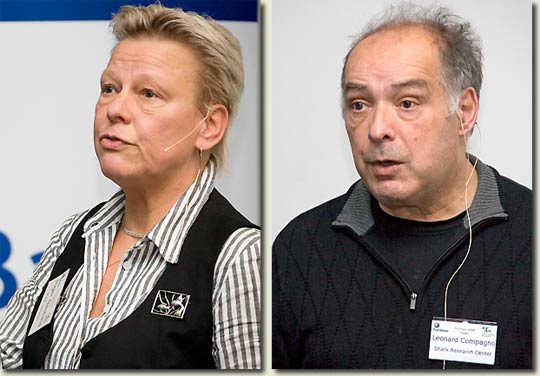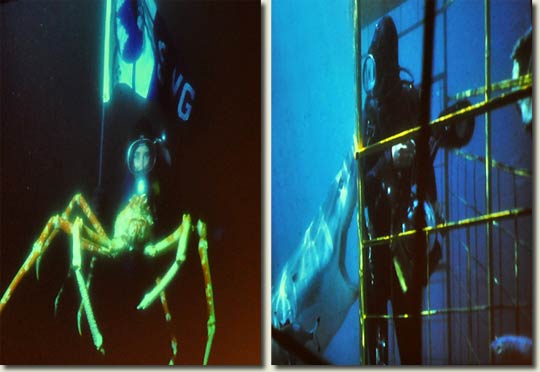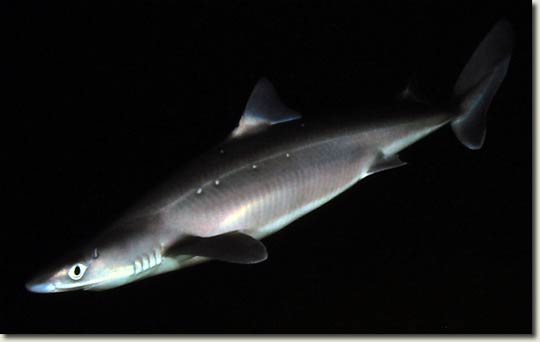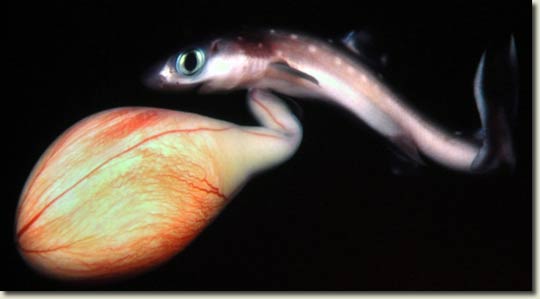Sweden – Stockholm, 19 October 2009
 The Fishbase Sweden organized a top event this year – an international Shark Symposium with some of the best known shark experts of the world and Heiko Bleher was invited to give a presentation on Sawfishes, family Pristidae. It took place in the beautiful Naturhistorika Riksmuseet in Stockholm.
The Fishbase Sweden organized a top event this year – an international Shark Symposium with some of the best known shark experts of the world and Heiko Bleher was invited to give a presentation on Sawfishes, family Pristidae. It took place in the beautiful Naturhistorika Riksmuseet in Stockholm.
The invitation to join the best known shark experts of the world and such celebrities as Eugenie Clark – the Shark Lady – and Leonard J. V. Compagno, was a great honour – to be together with them and several well known experts at the beautiful Naturhistorika Riksmuseet in Stockholm founded in 1819. It has been organized by Fishbase.org of Sweden and mainly coordinated by Sven O. Kullander. Below some photos of this fantastic event and first the 8 Speakers giving presentations.

Eugenie Clark and Heiko Bleher

Inger Näslund and Leonard J. V. Compagno

Anders Salesjö and Per Ericson

Sonja Fordham and Sven O. Kullander




Eugenie talked about Sea Monsters I Have Known with very impressive photo documentation of the last 50plus years from around the world, like encounter with giant crabs, whale sharks (Rhincodon typus) the largest living species of fish – and the tiniest, the cookie cutter shark (Isistius plutodus and I. brasiliensis), as well as encounters with the Great White (Charcharodon carcharias) hitting the cage and with the rare megamouth shark (Megachasma pelagios), the Greenland shark (Somniosus microcephalus), basking sharks (Cetorhinus maximus) and many others. And at the end she showed a film made from a submersible at 9000 feet deep of the most fascinating octopus living permanently in total darkness – the vampire octopus – Vampyroteuthis internalis.

Heiko Bleher was the second speaker and talked about the history of the Pristis, already published extensively in the Medieval but the and their taxonomy since Linneaus. Of 24 names (CAS) given only 7 are today recognized as valid. He himself introduced eight species during the lecture; knifetooth sawfish (Anoxypristis cuspidata), dwarf sawfish (Pristis clavata), greattooth sawfish (Pristis microdon) Leichhardt’s sawfish (Pristis leichhardti), smalltooth sawfish (Pristis pectinata) largetooth sawfish (Pristis perotteti) and longcomb sawfish (Pristis zijsron), which is considered the most common. Common sawfish (Pristis pristis) were thought to be extinct but Heiko Bleher saw a photograph of it just a few months ago.
Heiko Bleher also showed pictures from a expedition into the north and northwestern regions of Australia and the quest for the missing Pristis leichhardti. With 55 degrees in the shade the fish kept away, buried in the sand. During a night dive the first of these nocturnal fishes were discovered. Ten wild-caught specimens, all with 19 toothpairs on its rostrum, were transported live to Berlin were most of them lived for a long time, one even over 7 years in freshwater aquaria. He also told about other findings of hitherto undocumented species in freshwater habitats, like the one he discovered in Sumatra, in Panama (Pacific drainage) and remote places in Amazonia where a large population must have lived in the Rio Trombetas basin (northern tributary of the Amazon). He also talked about the extinct freshwater forms in New Guinea, Lake Nicaragua, and elsewhere, as well as some of the marine species, which have not been seen for over 30 years, like the ones along the coast of South Africa and those, which once were abundant in the Coral Triangle in the Indo-Pacific. He concluded showing the destruction of natural habitats of the freshwater species by Mining companies in Australia and New Guinea and requested the work for habitat conservation especially of the freshwater species and for a world-wide effort to breed them in aquaria to preserve them for future generations.

The Swedish Marine Biologist and representative at WWF Sweden, Inger Näslund, started with the topic “Sharkfins in the tasteless soup…”



Leonard J. V. Compagno started with what will be covered (shark cookies) and gave his latest classification and phylogeny of sharks. Leonard revealed the extensive work underway to classify and catalogue the sharks worldwide. His goal is to build consensus among various researchers, to have such an extensive catalogue of all the world’s shark species as possible. In 2001 FAO (the Food and Agriculture Organization of the United Nations) published the second edition of Sharks of the World, Part 2, compiled by Leonard Compagno. Part 1 has finally been compiled in 2008 and 2009 and during 2010, the third part is planned to be finished. Today, according to Compagno 1,240 documented species of shark. He also said that the great whites are attacking humans is a myth he wanted to shatter. For a white shark seal is a much more interesting meal choice.

Per Ericson’s presentation.

Sonja Fordham talked about conserving sharks and the Shark Alliance well represented in Brussels. Her focus was on Europe and the Baltic Sea region. The Shark Alliance consists of 76 organizations and the goal is to create an action plan to improve the situation for the sharks, and also to plug the loopholes in the legislation which allow shark fining to continue in Europe despite the EU-wide ban on fining in 2003. The Shark Alliance has estimated shark stocks in the EU and conclude that the EU is an important actor in shark fishing and trade of shark produce. The EU account for 30% of the worlds import of shark products and 40% of the worlds export, primarily through the trade in shark meat. The largest single actor in Europe is Spain, the worlds fourth largest trader of shark products.


Sven O. Kullander gave his presentation in Swedish and talked about Baltic Shark Research done by the Naturhistorika Riksmuseet where he is the Curator of Fishes.







Anders Salesjö is a well known excellent Swedish underwater photographer showed beautiful photos of sharks and other fishes from the Baltic and the North Sea – an incredible detailed photo-report.

At the end there was a film shown: “The end of the line” like 1950 in the world sea 8 million ton of fishes were harvested and in 2000 more than 10 times as many – 95 million tons…
There were 150 registered Delegates attending this great Symposium which took place in this beautiful hall of the Naturhistorika Riksmuseet perfectly organized. Thank you FishBase Servige and thank you Sven O. Kullander and Fang.
This post is also available in: English Italian German French Spanish







